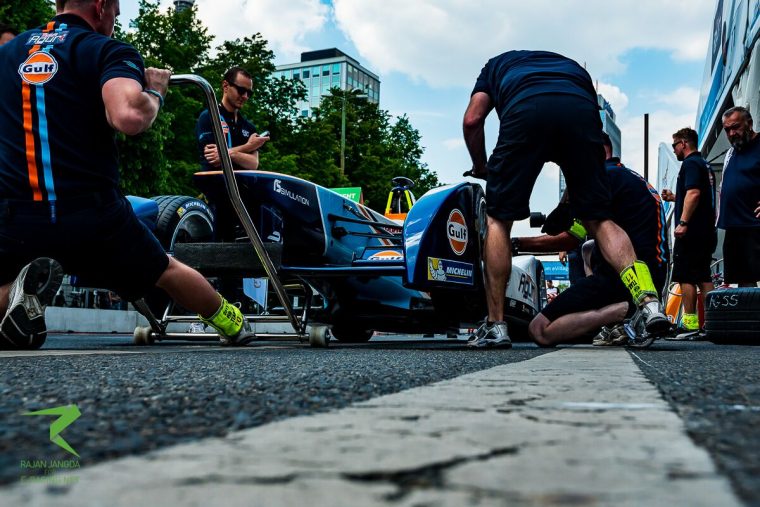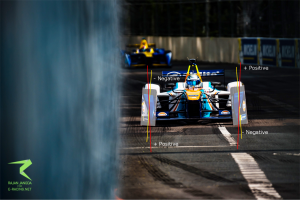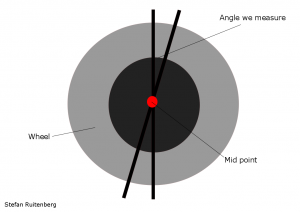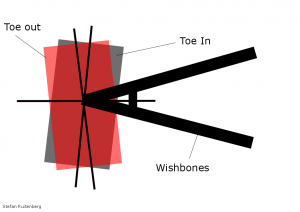Formula E race set up: The hidden nightmares
[vc_row][vc_column][vc_column_text]
From an outsider’s point of view it looks like most of the work is done on track by the driver, but they wouldn’t even be able to compete with teams of mechanics fine-tuning the car to find that perfect set up. But how do you find that optimal tuning for a Formula E car? Stefan Ruitenberg explains…
[/vc_column_text][/vc_column][/vc_row][vc_row][vc_column][vc_column_text]
Something I’ve wanted to cover for a long time now on this blog is the world of vehicle dynamics, a mind field for any beginning engineer. This is something which is over looked, but these mechanical systems play an important role in the driving characteristics of road and performance cars. Here is a rundown on the most important ones to note.
[/vc_column_text][/vc_column][/vc_row][vc_row][vc_column][vc_tta_tour][vc_tta_section title=”Camber” tab_id=”1459621372969-b19c37a4-57b9b42d-c253″][vc_column_text]
Starting off with camber, which is the angle of the wheel that is relative to vertical, as viewed from the front or the rear of the car. If the wheel leans in towards the chassis, you have negative camber; if it leans away from the car, you have positive camber. You can note this from the McLaren image above, whereby I have marked both positive and negative cambers. This is of critical important on F1 cars, but less some on road cars, as I shall explain.
The cornering force that a tyre can develop is high on the agenda, as its relative angle to the road surface, and so wheel camber has a major effect on the road holding of the car. It’s interesting to note that all tyres develop its maximum cornering grip of the tyre contact patch at a small negative camber angle, typically around neg. ‘1° to 2°’. This fact is due to the contribution of camber thrust, which is an additional lateral force generated by ‘elastic deformation’ as the tread rubber pulls through the tyre to the road surface or tyre contact patch, this is the section of the rubber which stays in contact with the roads surface 100% of the time.
To optimize a tyres performance in a corner, it’s the job of the suspension designer to keep the tyre 100% of the time at operating at a slightly negative camber angle. This can be a very difficult task, since, as the chassis rolls and flexes in a corner, the suspension must deflect some vertically away through whatever suspension type the car is running. From Formula 1 who have pushrod actuating design or too a road car which has coil springs. Since the wheel is connected to the chassis by several wishbones which must rotate to allow for the wheel deflection, the wheel can be subject to large camber changes as the suspension compresses moves up and down. For this reason, the more the wheel must deflect from its static position, the more difficult it is to maintain a quintessential camber angle. The relatively large wheel travel and soft roll stiffness needed to provide a smooth ride in passenger cars presents a difficult design challenge for engineers in the suspension world.
It’s important to draw the distinction between camber relative to the road, and camber relative to the chassis. To maintain the ideal camber relative to the road, the suspension must be designed so that wheel camber relative to the chassis becomes increasingly negative as the suspension deflects upward. If the suspension were designed so as to maintain no camber change relative to the chassis, then body roll would induce positive camber of the wheel relative to the road. Thus, to negate the effect of body roll, the suspension must be designed so that it pulls in the top of the wheel, so that it gains negative camber. For a Formula E of F1 chassis, this will cost the cars tyre contact patch.
For the road car industry, it’s a different manner, here’s why. While maintaining the ideal camber angle throughout the suspension travel assures that the tyre is at its optimum peak efficiency, designers often configure the front suspensions of passenger cars so that the wheels gain positive camber as they are deflected upward. The purpose of such a design is to reduce the cornering power of the front end relative to the rear end, so that the car will understeer in steadily greater amounts up to the limit of adhesion. Understeer is a much safer option due to the stable nature than oversteer, and thus is preferable for cars intended for the public use. In Formula E, if a team were to get the degree angle incorrect of the road surface and conditions, then the car would have less oversteer, and understeer more. The Spark chassis is only in its second season of use, so teams haven’t had too much time to look at the settings.
The best way to determine the proper camber for a racing car is to measure the temperature rejection across the tyres tread immediately after completing some aggressive laps. In general, it’s desirable to have the inboard edge of the tyre slightly hotter than the outboard edge. However, it’s far more important to ensure that the tyre is up to its proper operating temperature than it is to have an “ideal” temperature, which will lose performance. Thus, it may be advantageous to run extra negative camber to work the tyre up to temperature, as do Formula engineers do when the measure the heat coming off the carcass and tread.
[/vc_column_text][/vc_tta_section][vc_tta_section title=”Caster Angle” tab_id=”1459621373100-0d0836bb-6addb42d-c253″][vc_column_text]
The next section is caster angle, caster is the angle to which the steering pivot axis is tilted forward or rearward from vertical, as viewed from the side on to the car. If the pivot axis is tilted backward, that is, the top pivot is positioned farther rearward than the bottom pivot, then the caster is positive; if it’s tilted forward, then the caster is therefore negative.
Positive caster tends to straighten the wheel when the vehicle is traveling forward, and thus is used to enhance straight-line stability. The mechanism that causes this tendency is clearly illustrated by the castering front wheels of the car above.
Due to many design considerations, it is desirable to have the steering axis of a car’s wheel right at the wheel hub. If the steering axis were to be set vertical with this layout, the axis would be coincident with the tire contact patch. The trail would be zero, and no castering would be generated. The wheel would be essentially free to spin about the patch (actually, the tire itself generates a bit of a castering effect due to a phenomenon known as “pneumatic trail,” but this effect is much smaller than that created by mechanical castering, so we’ll ignore it here). Fortunately, it is possible to create castering by tilting the steering axis in the positive direction. With such an arrangement, the steering axis intersects the ground at a point in front of the tire contact patch, and thus the same effect as seen in the shopping cart casters is achieved.
For most cars, they are not too sensitive to caster changes, Nevertheless, it is important to ensure that the caster is the same on both sides of the car to avoid the tendency to pull to one side. While greater caster angles serve to improve straight-line stability, they also cause an increase in steering effort. When look at 2° to 5° of positive caster is the typical range of settings, with lower angles being used on heavier vehicles to keep the steering effort reasonable, thus more controllable.
[/vc_column_text][/vc_tta_section][vc_tta_section title=”Toe Angle” tab_id=”1459621598104-0550d32e-0db3b42d-c253″][vc_column_text]
When a pair of wheels is set so that their leading edges are pointed slightly towards each other, the wheel pair is said to have toe-in. If the leading edges point away from each other, the pair is said to have toe-out. The amount of toe can be expressed in degrees as the angle to which the wheels are out of parallel, or more commonly, as the difference between the track widths as measured at the leading and trailing edges of the tires or wheels. Toe settings affect three major areas of performance: tire wear, straight-line stability and corner entry handling characteristics. Some of the basic fundamentals of this follow, for minimum tire wear and power loss, the wheels on a given stub axle or hub of a car should point directly ahead when the car is running in a straight line. Excessive toe-in or toe-out causes the tires to scrub, since they are always turned relative to the direction of travel. Too much toe-in causes accelerated wear at the outboard edges of the tires, while too much toe-out causes wear at the inboard edges.
So if minimum tire wear and power loss are achieved with zero toe, why have any toe angles at all? The answer is that toe settings have a major impact on directional stability. The illustrations at right show the mechanisms involved. With the steering wheel centered, toe-in causes the wheels to tend to roll along paths that intersect each other. Under this condition, the wheels are at odds with each other, and no turn results.
When the wheel on one side of the car encounters a disturbance, that wheel is pulled rearward about its steering axis. This action also pulls the other wheel in the same steering direction. If it’s a minor disturbance, the disturbed wheel will steer only a small amount, perhaps so that it’s rolling straight ahead instead of toed-in slightly. But note that with this slight steering input, the rolling paths of the wheels still don’t describe a turn. The wheels have absorbed the irregularity without significantly changing the direction of the vehicle. In this way, toe-in enhances straight-line stability.
If the car is set up with toe-out, however, the front wheels are aligned so that slight disturbances cause the wheel pair to assume rolling directions that do describe a turn. Any minute steering angle beyond the perfectly centered position will cause the inner wheel to steer in a tighter turn radius than the outer wheel. Thus, the car will always be trying to enter a turn, rather than maintaining a straight line of travel. So it’s clear that toe-out encourages the initiation of a turn, while toe-in discourages it.
With four-wheel independent suspension, the toe must also be set at the rear of the car. Toe settings at the rear have essentially the same effect on wear, directional stability and turn-in as they do on the front. However, it is rare to set up a rear-drive race car toed out in the rear, since doing so causes excessive oversteer, particularly when power is applied. Front-wheel-drive race cars, on the other hand, are often set up with a bit of toe-out, as this induces a bit of oversteer to counteract the greater tendency of front-wheel-drive cars to understeer.
Remember also that toe will change slightly from a static situation to a dynamic one. This is most noticeable on a front-wheel-drive car or independently-suspended rear-drive car. When driving torque is applied to the wheels, they pull themselves forward and try to create toe-in. This is another reason why many front-drivers are set up with toe-out in the front. Likewise, when pushed down the road, a non-driven wheel will tend to toe itself out. This is most noticeable in rear-drive cars.
The amount of toe-in or toe-out dialled into a given car is dependent on the compliance of the suspension and the desired handling characteristics. To improve ride quality, street cars are equipped with relatively soft rubber bushings at their suspension links, and thus the links move a fair amount when they are loaded. Race cars, in contrast, are fitted with steel spherical bearings or very hard urethane bushings, metal or plastic bushings to provide optimum rigidity and control of suspension links. In other words, the bushings will have less damping effect to the harder ones, as there Is less give. Thus, a street car requires a greater static toe-in than does a race car, so as to avoid the condition wherein bushing compliance allows the wheels to assume a toe-out condition.
[/vc_column_text][/vc_tta_section][/vc_tta_tour][/vc_column][/vc_row][vc_row][vc_column][vc_column_text]
In the world of high performance motorsport, toe, caster and camber can provide a driver with the confidence he needs to push the car and a quick driver is a winning driver. Outside of motorsport, they provide ways to improve on dynamic safety in the road car division.
[/vc_column_text][/vc_column][/vc_row][vc_row][vc_column][vc_column_text]
[/vc_column_text][/vc_column][/vc_row][vc_row][vc_column][vc_column_text]
Main image courtesy of Rajan Jangda
Tech images courtesy of Stefan Ruitenberg
[/vc_column_text][/vc_column][/vc_row]








 No part of this website or any of its contents may be reproduced, copied, modified, adapted, used or distributed without the prior written consent of the author. e-racing.net is not responsible for the content of external sites or links.
No part of this website or any of its contents may be reproduced, copied, modified, adapted, used or distributed without the prior written consent of the author. e-racing.net is not responsible for the content of external sites or links.